Dominating the SERPs with the Surround Sound SEO Strategy
Getting quality links on trusted sites relevant to your brand is a tried-and-true method of increasing your own search rankings and website traffic. And all your hard work is likely paying off. In fact, a 2020 Backlinko study found that the #1 result in Google has an average of 3.8x more backlinks than positions 2-10.
What is the importance of being at the top of a search engine results page (SERP)? The brand that owns that coveted #1 spot is estimated to enjoy a click-through rate of close to 28%, while the #10 spot averages 2%. So it’s no wonder that link building is a central part of most brands’ SEO strategy.
But is there more to it than an endless quest to keep and retain the #1 spot for various keywords? Are there other opportunities to pursue? We think so, and it starts with share of search or SERP domination.
What is SERP Domination?
SERP domination goes beyond ranking your own website in the SERPs to being mentioned in as many high-ranking pages in the SERPs as possible. Even though no brands rank in the top spots of the following screenshot, brands Phillips and Oral-B are mentioned in every page that ranks on the first page of the SERPs. That is SERP domination.
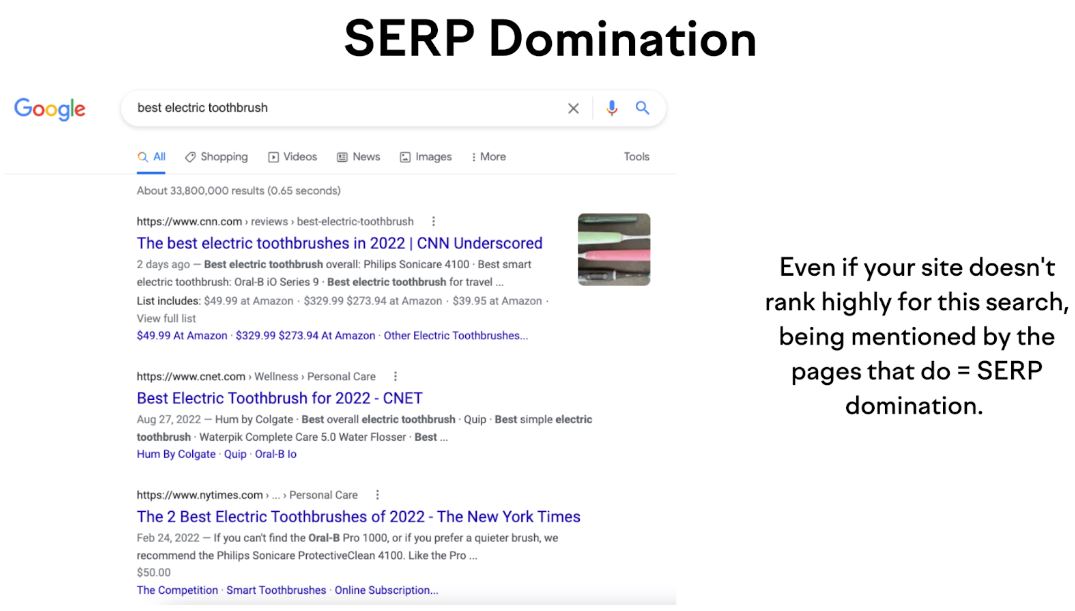
Even a brand with the deep pockets and brand recognition of Oral-B and Phillips can’t unseat CNN, CNET, or the New York Times for the top spots. But they can benefit from the rankings of those pages.
Why Does SERP Domination Matter to Your Brand?
Think about what you want from your search results when you know you want a new electric toothbrush, but you’re not sure which one to buy.
Chances are, you’re not expecting to be won over by what the brand itself says about the toothbrush. In fact, only 34% of us trust the brands we already buy from. You want to see what trusted, 3rd-party publications and people just like you are saying.
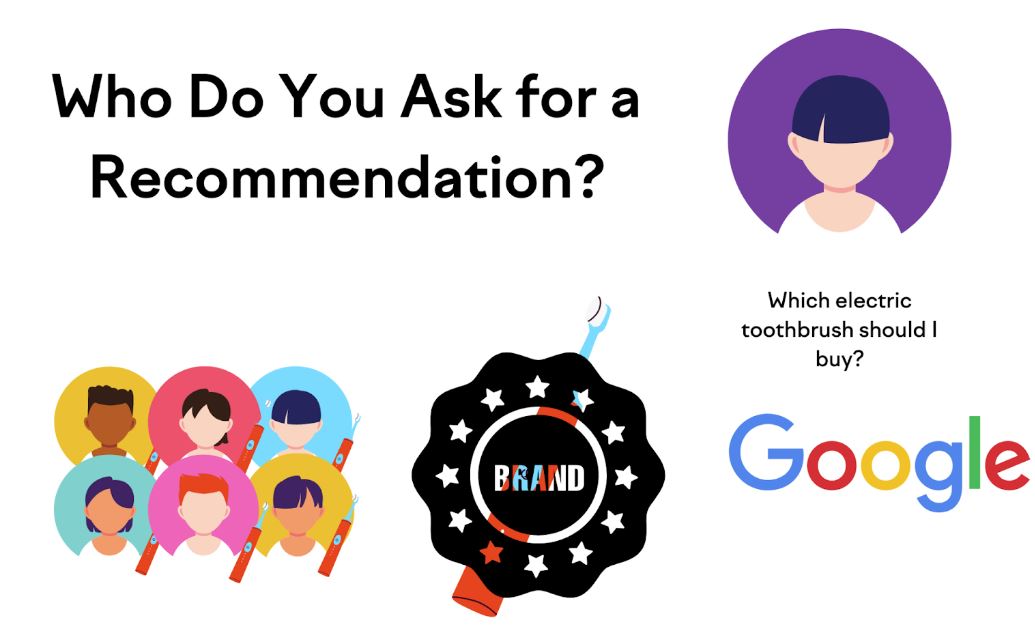
Chances are, your friends and trusted Google search results will have much more influence than anything the brand could say.
So, while ranking #1 for your commercial-intent keywords is a worthy goal, not to be overlooked is the benefit of being everywhere your customers are looking when they are ready to buy.
If I see the Philips Sonicare ProtectiveClean 5100 Electric Toothbrush mentioned favorably on EVERY ranking page on trusted sites (even if some placements are paid or affiliate links), it is going to be hard for me to ignore.

If all my friends endorse the same toothbrush, I’m going to seriously consider buying it! If Google recommends pages that all endorse the same toothbrush, I’m also going to seriously consider buying it.
5 Steps to Dominate the SERPs with the Surround Sound SEO Strategy
Now we know we want to be mentioned on as many pages that rank for our keywords as possible. Naturally, some of those spots might be owned by you and some might be owned by competitors, but there are going to be many that might mention you. Here’s how to find them.
1. Identify your commercial-intent keywords
These are your “best,” “easiest,” “most affordable” type keywords. Because we are trying to get close to the point where someone is deciding exactly what to buy, we will not go after “informational” keywords–your “how to” keywords. Examples of commercial-intent keywords include:
- Easiest approval credit card
- Fastest processor laptop
- Alternatives to (your competitor)
- Best running shoes for bad knees
Use the Semrush keyword magic to find related keywords. If you offer distinct products or services, evaluate them separately. You might want to know how you’re doing in the SERPs for all your product keywords, but you also want to know how you’re doing for each specific product or service.
For example, if you make shoes, you might have the following projects or Surround Sound campaigns:
- All our important keywords
- Keywords related to our athletic shoe line
- Keywords related to our sandals
- Keywords related to our comfort line
- Keywords related to our wedge sandals
You can get as specific if you want. If the above lineup reveals a weakness in any area when you get to step three, you can start with your Surround Sound SEO efforts there.
2. Identify your Competitors
Likely you have a pretty good idea of who your competitors are. If you break your campaigns into different products or lines of services, you will have more than one list of competitors. For athletic shoes, Nike will be a competitor, but they don’t belong on a competitor list for your wedge sandals.
3. See How you Stack Up
Now the fun part. It’s time to see how much share of search you have compared to competitors. You can do this one of two ways.
Method One – Manual:
- Using an incognito browser window, search each of your keywords.
- Review every page in the top 10-30 spots (you decide how deep to go).
- Look for and make a note of each time you are mentioned, your competitors are mentioned, and whether or not there is also a link.
- When you’re finished, figure out how much SERP coverage you have, which will be the percentage of top SERP pages that mention your brand.
- Now repeat for your competitors.
Method Two – Surround Sound from Semrush:
Surround Sound was designed to make dominating the SERPs, if not exactly easy, then certainly much easier and much faster. Here’s how to get started.
- Add your keywords and competitors to a new Surround Sound campaign.
- Hit enter.
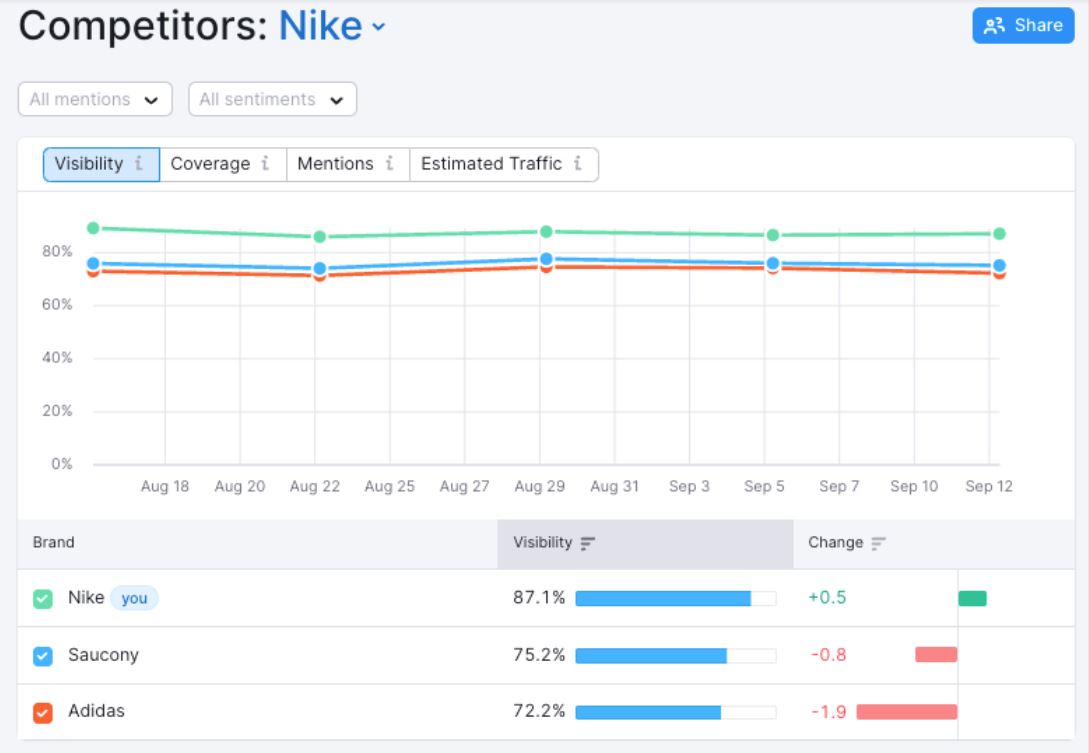
With Surround Sound you can also see your overall visibility, which is a weighted number that takes into account both the coverage of mentions and the ranking of the pages mentioning you. So, if you are mentioned in an article that ranks #1, that would count for more than a mention on a page ranking #20.
Here’s how to set up a Surround Sound campaign
4. Find Opportunities
Now it’s time to find out where you should pursue mentions and links. You’ll be looking especially for pages that do not mention you but do mention your competitors. Again, you can do this one of two ways.
Method One – Manual:
- For each ranking page that does not mention you, scan to see if they mention your competitors.
- If a page does not mention you but does mention competitors, check to see how much traffic that particular page gets.
- Prioritize high-traffic pages that mention competitors for the most potential impact because they’re more likely to be open to adding you than if they don’t mention any competitors.
Method Two – Surround Sound from Semrush:
- On the pages tab of the Surround Sound tool, select Opportunities from the drop-down menu.
- Click to sort by authority score or traffic.
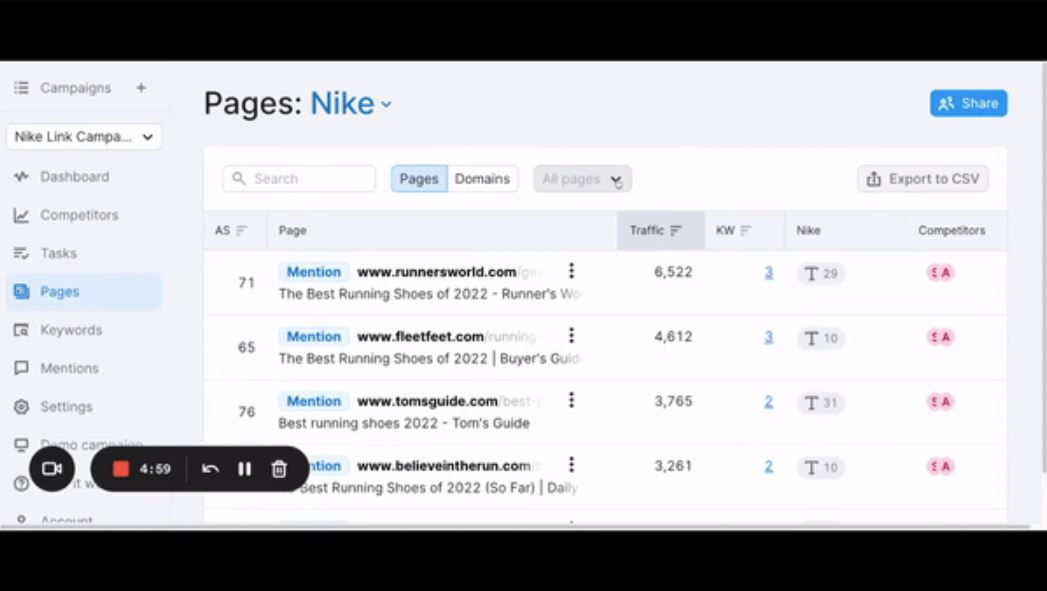
5. Reach Out to Get Mentions and Links
This is where Pitchbox comes in. Export a list of opportunities from Surround Sound and import them into a Pitchbox campaign. Set up your email templates and start reaching out to prospects. Here is how:
BONUS: Track your progress
Keep track of every new link you gain and lose manually, or use Surround Sound to keep track of your growing SERP domination.
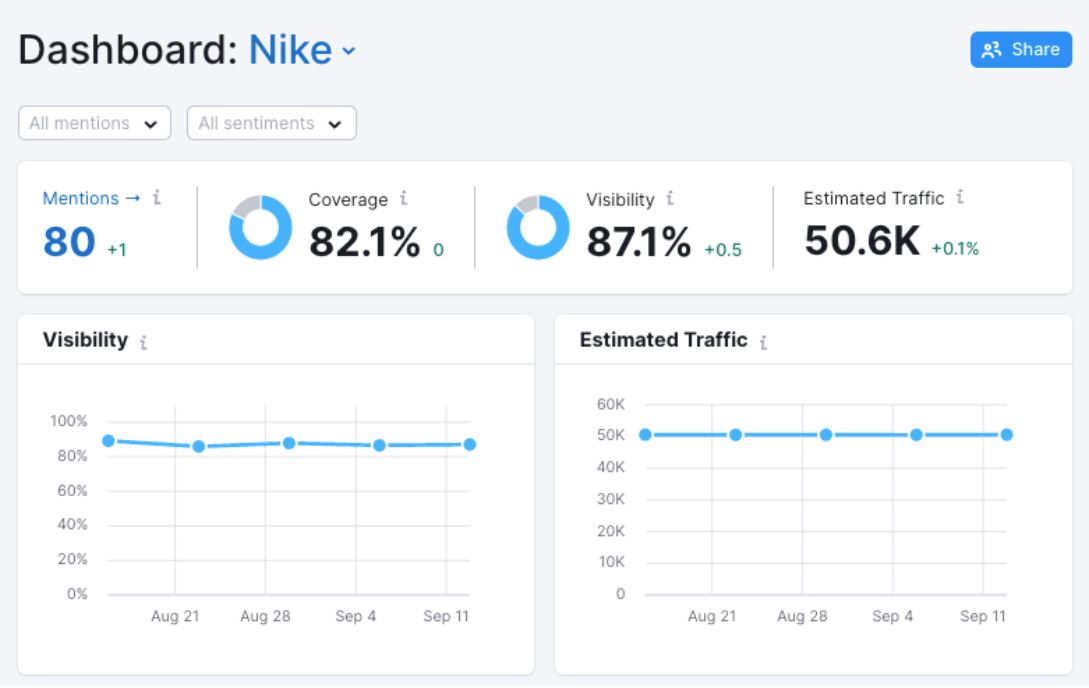
Are You Ready for SERP Domination?
SERP domination – being everywhere your buyers are searching online, is more critical than ever before. The vote of confidence from trusted 3rd-party publishers can give even smaller brands a leg up on the fiercest of competitors.
So go beyond ranking your own site to owning more than your fair share of search. The best time to start is now.
